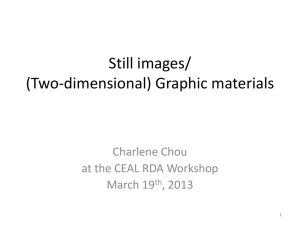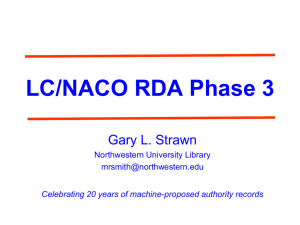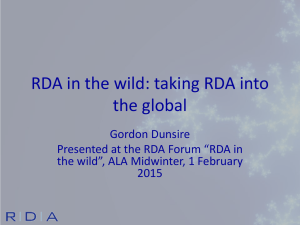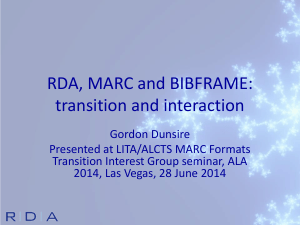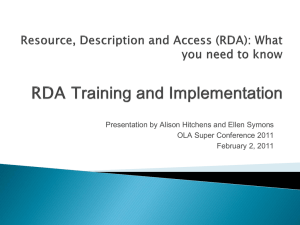RDA vs. AACR2
advertisement
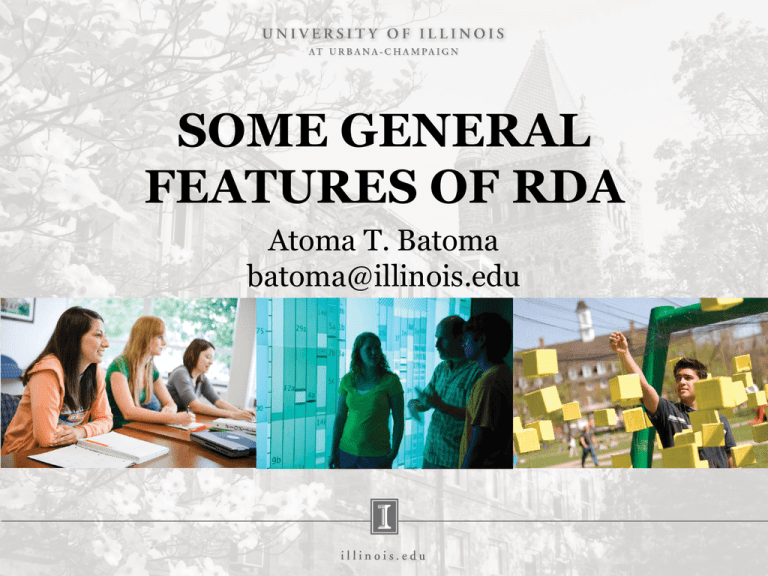
SOME GENERAL FEATURES OF RDA Atoma T. Batoma batoma@illinois.edu SOME GENERAL FEATURES OF RDA • RDA major goal: enhance the user’s retrieval and access experience, the so-called FRBR User needs/User tasks (find, identify, select and obtain) • FRBR conceptual model of entity-relationship offers a more effective means for realizing those tasks (convenience of the user); better adapted to the digital world. • RDA contains instructions and guidelines for, a)recording attributes for FRBR entities and the relationships between them as well as those creating them, b) describing resources and choosing access points and their form. SOME GENERAL FEATURES OF RDA •RDA is organized by FRBR entities and relationships Not by ISBD areas (AACR2) •RDA is organized in 10 sections that contain separate elements based on user tasks Not in chapters for classes of materials (AACR2) •RDA is focused on online resource Not on print resource (AACR2) SOME GENERAL FEATURES OF RDA • RDA is a Content Standard Not a display (presentation) standard like AACR2 (largely a content and display standard) Not an encoding schema (use whatever schema is appropriate to record data elements: Dublin Core, MODS, MARC, etc.) • MARC for the purpose of this training SOME GENERAL FEATURES OF RDA • Group 1 entities: Work, Expression, Manifestation, and Item. • Group 2 entities: People or “parties” responsible for the intellectual or artistic content, or the physical production, dissemination, etc, of manifestations of bibliographic resources: Persons, Families and Corporate bodies. • Group 3: Subjects of a work: Group 1and 2 entities + concepts, objects, places, events. SOME GENERAL FEATURES OF RDA • (Group 1) • Work: distinct intellectual or artistic creation (or content). • Identifiers (LC control number for example) – The sound and the fury, by William Faulkner – Le petit prince, by Antoine de Saint-Exupery SOME GENERAL FEATURES OF RDA • (Group 1) • Expression: intellectual or artistic realization of a work in the form of alpha-numeric, numerical or choreographic notation, sound, image, object, movement, etc. Identifiers LC control number, etc. – The sound and the fury by Faulkner (text) – Symphony No. 9, by Beethoven (musical notation) – The Nutcracker by the American Ballet Theatre (choreographic notation) – La Gioconda, by Leonard de Vinci (art object) SOME GENERAL FEATURES OF RDA • (Group 1) • Manifestation: physical embodiment of an expression of a work, i.e. expressions recorded in some physical form. Identifiers: ISSN, ISBN, publisher’s number, URN, URL, etc.) – The sound and the fury, by William Faulkner. London, Vintage, 1995. ISBN: 0099475014 SOME GENERAL FEATURES OF RDA • (Group 1) • Item: single exemplar or instance of a manifestation. Identifiers: call number, copy, location, item record #, etc. – The sound and the fury, by William Faulkner. London: Vintage, 1995. ISBN: 0099475014. UIU Undergrad., call #: PS3511.A86 S71995 SOME GENERAL FEATURES OF RDA • RDA Elements: Core and Core If elements (RDA 1.3) • Core elements are elements for describing resources selected from those that reflect attributes and relationships designated in FRBR and FRAD models as supporting user tasks. They are mandatory for a national level record. Example: Title proper (245, $a) RDA/LC, publication date (260, $c) RDA/LC, copyright date (260, $c) LC • Core if elements are data elements that become mandatory depending on the situation. Example: Copyright date (260, $c) RDA • Alternatives (institutional, local policies) SOME GENERAL FEATURES OF RDA • Vocabularies in RDA – Controlled vocabularies • Closed (a few), such as content, media, carrier types, mode of issuance, etc. • Open (most): catalogers can supply a term if needed term is not in the list. SOME GENERAL FEATURES OF RDA • Vocabularies in RDA (continued) – AACR2 to RDA vocabularies • Heading Authorized access point • Author, composer, etc. Creator • Main entry Preferred title + authorized access point for creator if appropriate • Uniform title (1) Preferred title (+ other information to differentiate; (2) conventional collective title SOME GENERAL FEATURES OF RDA • Vocabularies in RDA (continued) – AACR2 to RDA vocabularies • See reference • See also reference point for related entry • Physical description description variant access point authorized access carrier SOME GENERAL FEATURES OF RDA • Mode of issuance and type of description: (what I am cataloging?) – Mode of issuance : categorization reflecting whether a resource is in one or more parts, the way it is updated, and its intended termination (2.13.1.1 (single unit, multipart monograph, serial, integrating resource) • Single unit: resource issued as single physical unit ( single tangible vol. monograph) or single logical unit (pdf file on the web.) • Multipart monograph: resource issued in 2 or more parts (simultaneously or successively that is complete or intended to be completed in a finite numbers of parts. • Serial: resource issued in successive parts, usually bearing numbering, that has no predetermined conclusion. • Integrating resource: Resource that updates but does not remain discrete for integrated into the whole. SOME GENERAL FEATURES OF RDA • Mode of issuance and type of description: (what I am cataloging?) (continued) – Type of description (comprehensive vs. analytical, hierarchical) • Comprehensive: describes the resource as a whole • Analytical: describes a part of a larger resource • Hierarchical (also called multilevel): combines a comprehensive description of the whole resource with analytical descriptions of one or more of its parts. SOME GENERAL FEATURES OF RDA • Representation, or how to transcribe the data – ICP Principal: • • • • “Take what you see” “Accept what you get” See RDA 1.7.1 for general guidelines See also appendixes A on capitalization, B on abbreviations, and C on articles to omit. SOME GENERAL FEATURES OF RDA • Sources of information (expanded in RDA) – Preferred (not “chief”) source depends on the resource • Example: Parallel title: same source as title proper (AACR2), no restriction on location (RDA) • Example: Statement of responsibility: restricted number of sources in the resource (AACR2), no restriction on location (RDA). SOME GENERAL FEATURES OF RDA • The General Material Designation (GMD) replaced with – Content type: form of communication in which the content is expressed (text, musical notation, cartography, etc.) – Carrier type: format of the storage medium and housing of a carrier in combination with the type of intermediation device required to view, play, run, etc. (audiocassette, cartridge, slides, etc.) – Media type: general type of intermediation device required to view, play, run, etc., the content of a resource SOME GENERAL FEATURES OF RDA • No more “rule of 3” Options: – Name all the parties associated with the creation/ production/distribution of the resource in the statement of responsibility. – Name only one party and use “and others” strategy (give the number of parties). – Record the parties not chosen as main access point as added access points (the relationship designators are not mandatory). GENERAL FEATURES OF RDA vs. AACR2 Questions? GENERAL FEATURES OF RDA vs. AACR2 Suggested Readings RDA: Resource Description and Access, by the Joint Steering Committee for development of RDA, especially “Frequently Asked Questions”, http://www.rda-jsc.org/rdafaq.html RDA Core Elements: http://www.loc.gov/aba/rda/pdf/core_elements.pdf AACR2 to RDA using the RDA toolkit, webinar presented by Troy Linker http://www.rdatoolkit.org/webinar/2011Feb Oliver, Chris. Introducing RDA: A Guide to the Basics. ALA Editions, 2010 Several presentations of FRBR entity-relationships model are available on the web but Qiang’s presentation at the beginning of this training is a clear and informative summary of the model. GENERAL FEATURES OF RDA vs. AACR2 Suggested Readings • You may also find useful the following multilingual glossary of cataloging terms, which is at http://www.ifla.org/en/publications/multilingual-dictionaryof-cataloguing-terms-and-concepts-muldicat

